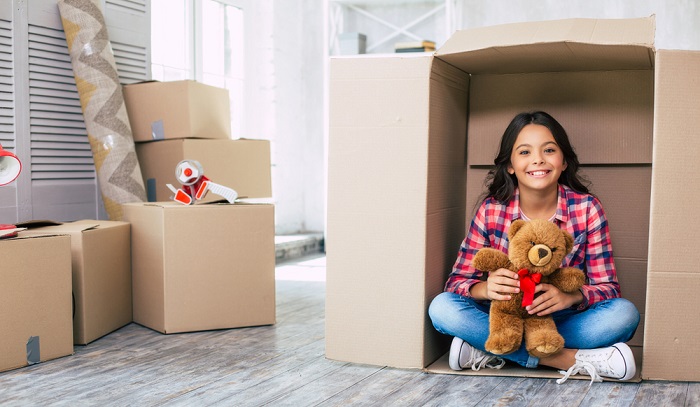Moving to a new home can be a whirlwind of activity and emotions for everyone involved, especially for children. Whether it’s across town or across the country, relocating can be particularly challenging for the younger members of the family, who may not fully understand the reasons for the move or what it entails. Luckily, there are things you can do to help your children through this process. From keeping communication open to involving them in the moving process, we’ll explore effective ways to support your children’s emotional needs and help them adjust to their new home.
Tour the New House With Them
Giving your children a chance to familiarize themselves with the new house will go a long way. It establishes the new home as an actual place the child can visualize. They’re no longer moving into an unknown environment; it’s a location with a reference point for them. Repeated visits will help strengthen that familiarity.
If your child is old enough (and the new home isn’t in another state), you might want to bring them along on house tours. By including them in the process and showing interest in their opinions, you can help create a sense of belonging in the new home. After all, they’ve had a say in their new living space and built connections that will make the move less frightening.
If an in-person tour isn’t possible, you may be able to show your child the home using an online virtual tour, or share videos you took during your own visits.
Give Your Children a Role in Moving Decisions

While the final say on the new home is up to you, let your children make some choices of their own. For example, let them choose which bedroom will be theirs, as well as any paint, decorations, or new furniture for their room. You might want to consider letting them decorate the boxes that are holding their belongings. This can extend to the day of the move. Encourage them to pick out a special moving day outfit or playlist to listen to on the way over. Granting children autonomy is the key to helping them adjust.
Talk to Your Kids
The easiest way to help your kid adjust is to talk to them about the move. Explain why the move is necessary and that it’s difficult for you as well. Reassure them that the move isn’t a punishment. Above all, remind your child how much you love them. A healthy dialogue will go a long way.
Remember that a dialogue isn’t necessarily just one conversation. Revisit the subject and remind your children that they can always ask you questions about the move.
Acknowledge Their Feelings
Even if your kids participate in moving preparation, they’ll have likely conflicting emotions about the ordeal. The most common negative emotion is grief. Depending on how young your child is, the move may take them from the only place and people they’ve ever known. If you’re moving between states or countries, it’ll be even more traumatic.
Give them the chance to grieve what they’re leaving behind, and assure them that their feelings are valid. Encourage them to collect photos or other reminders of friends or favorite places around the old home. If they’re scared, reassure them that you’re nervous as well. But also encourage any positive emotions they might have, such as excitement.
Spend Time With Your Kids
Children might feel disconnected from their parents during the moving process. Reassure them that they’re still your priority, then prove it by spending time with them. If they have any favorite places around their old home, take them there for a final, extra-special time. Make it a real occasion as well. Buy or bring snacks, indulge in a souvenir, and so on.
At the same time, you might want to take your kids to new attractions near the new house. Parks, museums, and libraries are good starting points. This will give you and your children some quality time together and introduce them to the new area and make the move less daunting. Even if it’s just bringing them along grocery shopping for the new house, you’re including them and reminding them how much you love them.
Moving is a stressful and busy time, but don’t let it disrupt your routine and keep you from spending time with your children as usual!
Maintain a Schedule
Speaking of disruptions, it’s important to keep things as consistent as possible for your children before and after your move.
Your family may follow a certain routine. For example, you may have dinner at 6:30 p.m. on weeknights and 7 p.m. on weekends. Keep that schedule the same as much as possible after the move. This will help establish a sense of normalcy in the new home. Bedtimes, bath times, mealtimes, and even the times when the dog goes potty outside — if something was established at the old house, continue it at the new place.
Unpack the Kids’ Rooms First

While it’s tempting to dive headfirst into the kitchen or master bedroom, it’ll be more beneficial to establish your child’s space first. Seeing their belongings in their new home will make the location more welcoming. It’ll also give them a place to relax after the long journey and keep them out of the way as you unpack the rest of the house or new apartment.
To offer extra autonomy, install large furniture items yourself. Assist your kids in decorating walls, hanging up clothes, and filling bookshelves. Then, allow them to rearrange toys and stuffed animals on their own. Any sense of control you can offer will help them settle in.
Packing up your children’s things last and unpacking those things first will help minimize disruptions to their routines and environments.
Create a Moving Book
A moving book is a scrapbook, created to help your children understand what the move involves. For example, it might start with pages about the current home, the kids’ schools, and their favorite places to eat or visit. You might also want to include pictures of their friends and teachers.
Then, transition into the new neighborhood. Use photos of the new house, exciting places near the house, and their new school. Also include pictures of them with the family. This will help establish a positive connection. It’ll also reassure younger children that they won’t be forgotten or left behind during the move, which is a common fear. (The same goes if you’re moving with a pet. Assure them that their furry friends will come along too.)
If you choose to include a written story, make sure it continues to acknowledge the child’s conflicting feelings. End the story on a hopeful and positive note. Allow the child to keep and reread the book whenever they want. Depending on their age, it may take them a while to fully accept or understand the situation.
Take Care of Yourself, Too

Moving is already stressful, and your child’s anxieties will only add to the stress. For that reason, it’s crucial you practice self-care whenever possible. Don’t stay up late packing boxes. Enjoy any luxuries your current home has that your new home doesn’t. Meditate and center yourself before helping your kids pack. Whatever little things you can manage will help grant you the patience you need to help your kids adjust.



